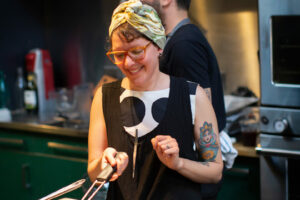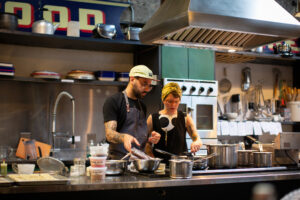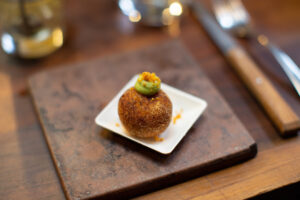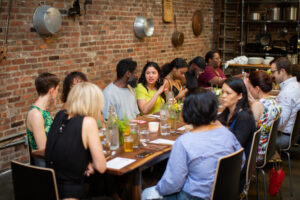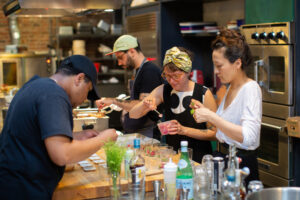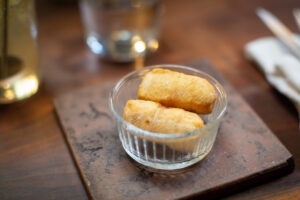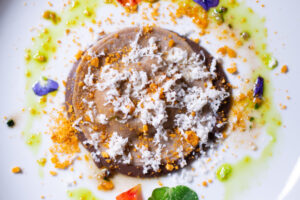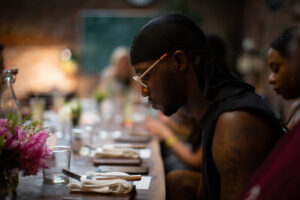
“Food is part of culture and culture reshapes itself constantly. Nothing is static. Even the same dish prepared by different people using the same recipe will taste different,” says Mercedes Golip, a Venezuelan transplant and self-taught chef who lives in Astoria. For Golip, food is the conduit through which she connects to a culture that she has been removed from for the last 12 years. Her expression of Venezuelan cuisine defines the culinary classes and seasonal pop-up dinners she regularly hosts at the Brooklyn Kitchen, but in many ways the dishes she creates are purposefully antithetical to the traditional food she grew up eating.
Golip’s approach to cooking begins with the question “How can I separate my food from the industrialized products that I was used to?” as a way to gain agency over her food and support environmentally responsible agricultural practices. The answer for her lies in “turning to heirloom seeds and locally grown produce to create and reshape Venezuelan food with a little more thoughtfulness,” she tells me.
Her curiosity for food and skill in preparing it have slowly developed since she was a self-described picky eater who was afraid to branch out from her meat and potatoes diet. All of that changed after she met her husband whose adventurous eating habits rubbed off on her. They immigrated to the United States together 12 years ago. Five years ago, they moved from Miami, where she moonlighted as a sous chef on her friend’s food truck, to New York City, where she joined a CSA and began swapping standard ingredients in Venezuelan dishes for seasonal alternatives grown on local farms. She often found herself wondering, “Is this still Venezuelan food?”
Social media opened up a door for her to share her culinary experiments with the world and learn from others who were doing the same. Having been vegan for eight months due to digestive issues, Golip has developed vegan recipes for ceviche and tequeños (Venezuelan cheese sticks). She uses a pre-Columbian indigenous method of making corn more digestible (called “nixtamalization”) in making her own masa with freshly ground corn for arepas—Venezuelans’ daily bread—which she kneads like Play-Doh, using the dough as a canvas for creating bright marbled hues from powdered pea flowers, dragon fruit and turmeric or using powdered beets to transform the soft discs into an edible pink gradient.

But sometimes Golip’s tinkering in the kitchen garners attention from home cooks and chefs in Venezuela who gently wag their fingers in private messages, “telling me how to do this or that,” she says. Golip tries to avoid using processed ingredients—despite how familiar or nostalgic they may be—or buying produce out of season, something that people living in Venezuela don’t have much of a choice with unless they grow their own food, which she encourages her mother to consider, if not for sustenance then for mental health.
“My parents still live there and I hear from them every week, every day about how bad it’s getting,” Golip sighs. Cooking has become a difficult topic of conversation with them as food shortages continue to escalate. Scarcity from economic depression and political upheaval has forced people in Venezuela to change their relationship with food in ways that Golip has embraced in the U.S., like planting a backyard garden or laboriously grinding her own corn. “It’s really hard, but in the scarcity you also find creativity,” she says. “And that’s something we failed to do sooner. It’s something we could have explored earlier without being forced into it.”
Golip’s most recent farm-to-table pop-up dinner took place at the Brooklyn Kitchen in early June, showcasing a colorful array of late-spring produce from nearby farms throughout the seven-course feast. Before a long wooden table buzzing with guests’ chatter and clinking glasses filled with fresh-made rhubarb mojitos, Golip and her small team artfully prepared and plated each dish, with vegan and non-vegan versions of each.
https://www.instagram.com/p/Bj0ThKWH0ce/?taken-by=iambananista
Crispy plantain puffs crowned with cilantro cream were followed by warm Iroquois corn arepas (Golip’s recipe below) and chilled glasses of silky asparagus and pea gazpacho adorned with bright flower petals and drizzled with herb-infused oil. Dense corn dumplings swimming with shiitakes, dill and yellow petals in a translucent mushroom broth provided a warming prelude to the main course, pabellón, made with eggplant or short-rib ravioli (depending on dietary preference) flecked with crispy sweet plantains and resting on a bed of velvety black beans. As all good meals should, Golip’s finished on a sweet note. Thickly sliced strawberries and their juices spilled leisurely over dollops of cream, lemon curd and finely crumbled shortbread cookies.
Part of her work preparing pop-up dinners and teaching cooking classes on Venezuelan cuisine is to use food as a vehicle for education. “I’m telling the story of what’s missing in Venezuela through what we’re eating here,” Golip explains, in hopes of enriching the image of Venezuelan food through her cooking and encouraging individuals to cultivate their own sense of culinary agency.
“Food is revolutionary when you take control over what you eat and know where your money is going,” she says emphatically. “And do it before the crisis, which shapes the outcome.”
You can follow Golip on Instagram to learn where she’ll be popping up next. See below for her Iroquois corn arepas recipe.

Iroquois Corn Arepas
By Mercedes Golip
This is a pre-Columbian preparation made by indigenous tribes from what is now known as Colombia and Venezuela; one of the few pre-contact traditions that remains popular nowadays. Arepas are flat patties made mostly of maize—there are also other versions made with yucca, plantain, wheat and so forth—depending on the region. They can be topped or filled with different meats, cheese, legumes or vegetables. It’s considered the daily bread. These have been made with Iroquois white corn, an heirloom non-GMO grain that is hand-grown, hand-picked and hand-processed in New York. It’s known to be very nutritious, naturally gluten-free and has a low glycemic index.
Makes 12 arepas
Difficulty: medium
Prep time: 1 hour plus soaking time
Cooking time: 15 mins
Gluten-Free
Tips and tricks:
• If you are serving a large crowd, you can shape the arepas in advance, place them on a tray and keep them in the fridge, covered with a clean damp towel to prevent dryness.
• For a quick fix, you can sear them and keep them frozen. Pop them in the oven for about 15 minutes until they make a hollow sound when ready.
• To flavor the dough you can use vegetables purees or juices instead of water. You can also add grated cheese to the masa.
• This masa can be stored in the fridge for 1–2 days if made in advance. When ready to use, let it reach room temperature and form the arepas, adjust with water and salt if needed.
Ingredients:
1 pound hulled Iroquois corn
10 cups water to cook the corn
2½ teaspoons salt
2 tablespoons oil
⅓ cup reserved from cooking water to knead
1 teaspoon oil for cooking pan
Equipment:
1 bowl
1 medium-size pot
1 grain mill
1 large nonstick or cast-iron skillet
1 spatula
Directions:
- Soak the corn overnight.
- Discard the soaking water.
- Cook the corn in 10 cups of water at high heat, until the grain is al dente (just like pasta, firm to the bite), about 30–45 minutes.
- Once cooked, strain and save about ⅓ cup of the cooking water to knead the masa. Stir now and then to make sure the corn doesn’t stick to the bottom.
- Remove from the heat and let chill at room temperature.
- Make the masa by passing the cooked grains through a grain mill, adjust it very tight so the masa comes out soft and smooth.
- Add ⅓ cup cooking water, salt and oil and knead for about 5–6 minutes until all is combined. The masa should not be sticky to the hands.
- Divide the dough into 12 balls, measuring with the palm of your hand and form them into patties.
- Add the oil to the pan and spread with a paper towel.
- Place the arepas in the pan, and sear each side, about 4 minutes per side, until golden brown.
- Finish in a hot oven for about 10 minutes until they make a hollow sound when tapped.
- Cut them open and fill them right away.
The most popular fillings include fresh Venezuelan white cheese (cheese curds make a really good substitution), legumes (especially black beans), cold cuts, scrambled eggs, avocado and stews.



